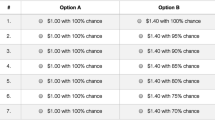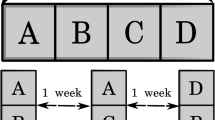Abstract
This field experiment investigated the contextual effect of presentation order on probability judgments supporting risky decisions in a representative setting: the betting markets of live horseraces. Participants were 54 contestants in a wagering tournament at a national thoroughbred racetrack. Prior to each of 11 races the expert gamblers recorded their estimated odds for all horses to win. Presentation order was manipulated by re-ordering the judgment-related information printed in the track’s program that had been provided for horses in an earlier race. Findings revealed the subjective probability estimates of most gamblers were not invariant with respect to presentation ordering. Probability judgments and risky choices were also associated with the predictive information provided for the gamble first processed during decision making. These results directly contradict calibration findings that probability judgments in this market are highly accurate and they are discussed in terms of the representative experimental design’s utility.

Similar content being viewed by others
References
Ayton, P., & Wright, G. (1994). Subjective probability: What should we believe? In G. Wright & P. Ayton (Eds.), Subjective probability. Chichester: Wiley.
Banks, W. P. (1977). Encoding and processing of symbolic information in comparative judgments. In G. H. Bower. In The psychology of learning and motivation (Vol. 11). New York: Academic Press.
Beach, L. R., Christensen-Szalanski, V., & Barnes, J. (1987). Assessing human judgment: Has it been done, can it be done, should it be done? In G. Wright & P. Ayton (Eds.), Judgmental forecasting. Chichester: Wiley.
Berger, J. (2016). Does presentation order impact choice after delay? Topics in Cognitive Science, 8, 670–684.
Bettman, J. R., Luce, M. F., & Payne, J. W. (1998). Constructive consumer choice processes. The Journal of Consumer Research, 25, 187–217.
Bruce, A. C., & Johnson, J. E. V. (1992). Toward an explanation of betting as a leisure pursuit. Leisure Studies, 11, 201–218.
Bruine de Bruin, W. (2005). Save the last dance for me: Unwanted serial position effects in jury evaluations. Acta Psychologica, 118, 245–260.
Bruine de Bruin, W., & Keren, G. (2003). Order effects on judgments in sequentially judged options due to the direction of comparison. Organizational Behavior and Human Decision Processes, 92, 91–101.
Brunswik, E. (1955). Representative design and probabilistic theory in a functional psychology. Psychological Review, 62, 193–217.
Budescu, D. V., & Johnson, T. R. (2011). A model-based approach for the analysis of the calibration of probability judgments. Judgment and Decision making, 6, 857–869.
Busler, J. N., & Lazarte, A. A. (2017). Reading time allocation strategies and working memory using rapid serial visual presentation. Journal of Experimental Psychology: Learning, Memory, and Cognition, 43(9), 1375–1386.
Carlson, B. W. (1990). Anchoring and adjustment in judgments under risk. Journal of Experimental Psychology: Learning, Memory, and Cognition, 16, 665–676.
Dean, M. L. (1980). Presentation order effects in product taste tests. Journal of Psychology, 105, 107–110.
Englich, B., Mussweiler, T., & Strack, F. (2006). Playing dice with criminal sentences: The influence of irrelevant anchors on experts’ judicial decision making. Personality and Social Psychology Bulletin, 32, 188–200.
Ginsburg, V., Archambeau, K., van Dijck, J., Chetail, F., & Gevers, W. (2017). Coding of serial order in verbal, visual, and spatial working memory. Journal of Experimental Psychology: General, 146(5), 632–650.
Goodwin, P., & Wright, G. (1992). Decision analysis for management judgement. Chichester: Wiley.
Hastie, R., & Dawes, R. M. (2010). Rational choice in a uncertain world: The psychology of judgment and decision making. Thousand Oaks: SAGE Publications.
Herbig, B., & Glöckner, A. (2009). Experts and decision making: First steps towards a unifying theory of decision making in novices, intermediates and experts. Preprints of the Max Planck Institute for Research on Collective Goods, No. 2009, 2.
Hershey, D. A., Walsh, D. A., Read, S. J., & Chulef, A. S. (1990). The effects of expertise on financial problem solving: Evidence for goal-directed, problem-solving scripts. Organizational Behavior and Human Decision Processes, 46, 77–101.
Huber, O. (2012). Risky decisions: Active risk management. Current Directions in Psychological Science, 21, 26–30.
Huber, O., & Huber, O. W. (2008). Gambles vs. quasi-realistic scenarios: Expectations to find probability and risk-defusing information. Acta Psychologica, 127, 222–236.
Huber, O., Wider, R., & Huber, O. W. (1997). Active information search and complete information presentation in naturalistic risky decision tasks. Acta Psychologica, 95, 15–29.
Hughes, R. W., & Marsh, J. E. (2017). The functional determinants of short-term memory: Evidence from perceptual-motor interference in verbal serial recall. Journal of Experimental Psychology: Learning, Memory, and Cognition, 43(4), 537–551.
Johnson, J. E. V., & Bruce, A. C. (2001). Calibration of subjective probability judgments in a naturalistic setting. Organizational Behavior and Human Decision Processes, 85(2), 265–290.
Johnson, J. E. V., Schnytzer, A., & Liu, S. (2009). To what extent do investors in a financial market anchor their judgments excessively? Evidence from the Hong Kong horserace betting market. Journal of Behavioral Decision Making, 22, 410–434.
Jou, J. (2010). Serial position, distance, and congruity effects of reference point setting in comparative judgments. American Journal of Psychology, 123, 127–136.
Kahneman, D., & Tversky, A. (1979). Prospect theory: An analysis of decision under risk. Econometrica, 47, 263–291.
Kahneman, D., Slovic, P., & Tversky, A. (1982). Judgment under uncertainty: Heuristics and biases. Cambridge: Cambridge University Press.
Keren, G. (1997). On the calibration of probability judgments: Some critical comments and alternative perspectives. Journal of Behavioral Decision Making, 10, 269–278.
Keren, G., & Wagenaar, W. A. (1987). Violation of utility theory in unique and repeated gambles. Journal of Experimental Psychology: Learning, Memory, and Cognition, 13, 387–391.
Li, Y., & Epley, N. (2009). When the best appears to be saved for last: Serial position effects on choice. Journal of Behavioral Decision Making, 22, 378–389.
Lichtenstein, S., & Slovic, P. (Eds.). (2006). The construction of preference. New York: Cambridge University Press.
Lichtenstein, S., Fischhoff, B., & Phillips, L. D. (1982). Calibration of probabilities: The state of the art to 1980. In D. Kahneman, P. Slovic, & A. Tversky (Eds.), Judgment under uncertainty: Heuristics and biases. Cambridge: Cambridge University Press.
Loewenstein, G., Weber, E. U., Hsee, C., & Welch, N. (2001). Risk as feelings. Psychological Bulletin, 127, 267–286.
Malhotra, N. K. (1982). Information load and consumer decision making. Journal of Consumer Behaviour Research, 8, 419–430.
Mantonakis, A., Rodero, P., Lesschaeve, I., & Hastie, R. (2009). Order in choice: Effects of serial position on preferences. Psychological Science, 20(11), 1309–1312.
McClelland, A. G. R., & Bolger, F. (1994). The calibration of subjective probabilities: Theories and models 1980-94. In G. Wright & P. Ayton (Eds.), Subjective probability. Chichester: Wiley.
Mussweiler, T., & Strack, F. (1999). Hypothesis-consistent testing and semantic priming in the anchoring paradigm: A selective accessibility model. Journal of Experimental Social Psychology, 35, 136–164.
von Neumann, J., & Morgenstern, O. (1947). Theory of games and economic behavior. Princeton: Princeton University Press.
Orasanu, J., & Connolly, T. (1993). The reinvention of decision making. In G. A. Klein, J. Orasanu, R. Calderwood, & C. E. Zsambok (Eds.), Decision making in action: Models and methods. Norwood: Ablex.
Philips, L. D. (1987). On the adequacy of judgmental forecasts. In G. Wright & P. Ayton (Eds.), Judgmental forecasting. Chichester: Wiley.
Plous, S. (1993). The psychology of judgment and decision making. New York: McGraw-Hill.
Rapoport, A., & Tversky, A. (1970). Choice behavior in an optional stopping task. Organizational Behavior and Human Performance, 5, 105–120.
Russo, J. E., Carlson, K. A., & Meloy, M. G. (2006). Choosing an inferior alternative. Psychological Science, 17, 899–904.
Schuman, H., & Presser, S. (1981). Questions and answers in attitude surveys: Experiments on question form, wording, and context. Orlando: Academic Press.
Shoben, E. J., & Wilson, T. L. (1998). Categorization in judgments of relative magnitude. Journal of Memory and Language, 38, 94–111.
Simmons, J. P., LeBoeuf, R. A., & Nelson, L. D. (2010). The effect of accuracy motivation on anchoring and adjustment: Do people adjust from provided anchors? Journal of Personality and Social Psychology, 99(6), 917–932.
Simonson, I., & Tversky, A. (1992). Choice in context: Tradeoff contrast and extremeness aversion. Journal of Marketing Research, 29, 281–295.
Slovic, P. (1995). The construction of preference. American Psychologist, 50, 364–371.
Strack, F., & Mussweiler, T. (1997). Explaining the enigmatic anchoring effect: Mechanisms of selective accessibility. Journal of Personality and Social Psychology, 73, 437–446.
Tetlock, P. E. (1985). Accountability: The neglected social context of judgment and choice. Research in Organizational Behavior, 7, 297–332.
Tversky, A., & Kahneman, D. (1974). Judgment under uncertainty: Heuristics and biases. Science, 185, 1124–1131.
Tversky, A., & Kahneman, D. (1986). Rational choice and the framing of decisions. Journal of Business, 59, 251–278.
Unkelbach, C., Ostheimer, V., Fasold, F., & Memmert, D. (2012). A calibration explanation of serial position effects in evaluative judgments. Organizational Behavior and Human Decision Processes, 119, 103–113.
Wright, W. F., & Bower, G. H. (1992). Mood effects on subjective probability assessment. Organizational Behavior and Human Decision Processes, 52, 1–18.
Yates, J. F. (1990). Judgment and decision making. Englewood Cliffs: Prentice Hall.
Yates, J. F., & Tschirhart, M. D. (2006). Decision-making expertise. In K. A. Ericsson, N. Charness, R. R. Hoffman, & P. J. Feltovich (Eds.), The Cambridge handbook of expertise and expert performance (pp. 421–438). Cambridge: Cambridge University Press.
Author information
Authors and Affiliations
Corresponding author
Ethics declarations
All procedures performed in this study involving human participants were in accordance with the ethical standards of the institutional human research protections committee and with the 1964 Helsinki declaration and its later amendments or comparable ethical standards.
Conflict of Interest
The author declares that he has no conflict of interest.
Informed Consent
Informed consent was obtained from all individual participants included in the study.
Rights and permissions
About this article
Cite this article
Wilson, T.L. The Influence of Presentation Order on Probability Judgments in a Representative Market Setting. Curr Psychol 38, 1265–1275 (2019). https://doi.org/10.1007/s12144-017-9677-6
Published:
Issue Date:
DOI: https://doi.org/10.1007/s12144-017-9677-6




